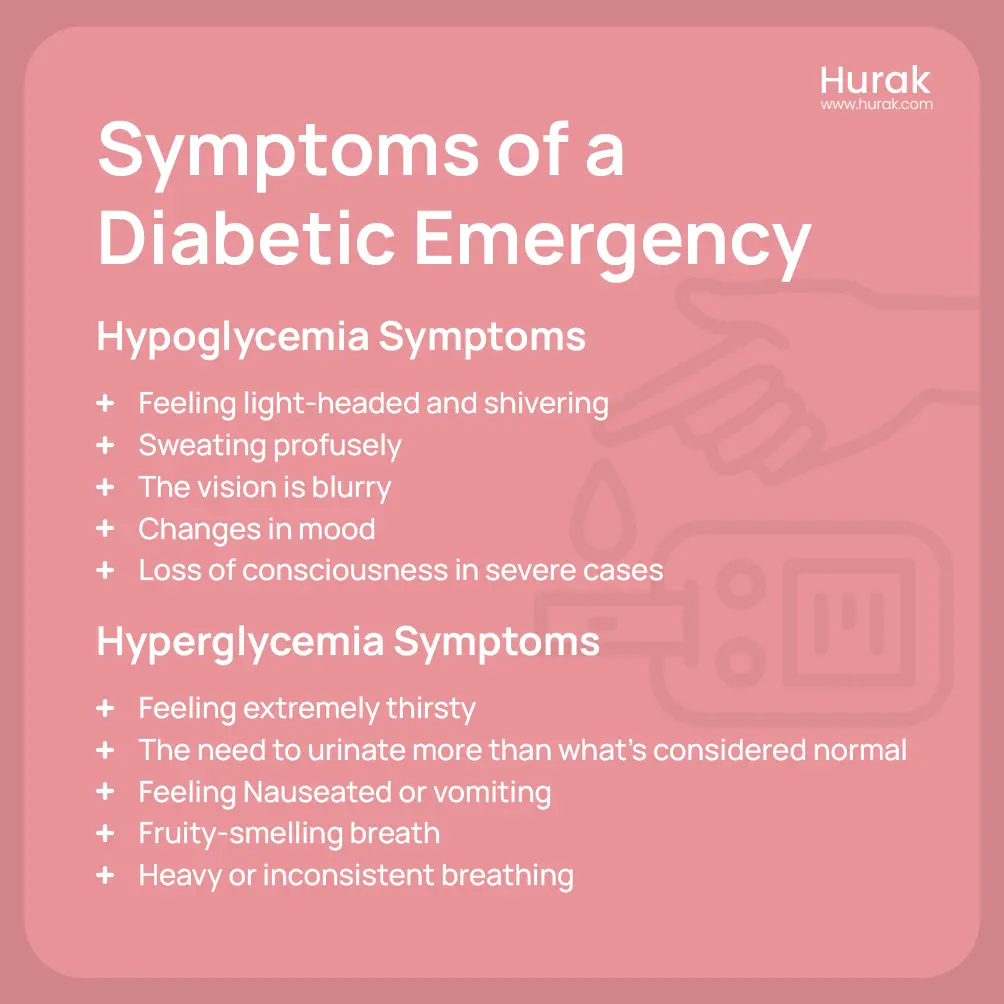Diabetes is a condition that affects the body’s ability to regulate blood sugar. A diabetic attack occurs when blood sugar levels fluctuate suddenly, posing serious health risks if not addressed quickly. Recognizing the symptoms and knowing how to respond are crucial.
Let’s explore common triggers, warning signs, and essential first-aid measures to manage a diabetic attack effectively.
What is a Diabetic Episode?
A diabetic episode is caused by blood sugar levels dropping dangerously low also known as hypoglycaemia. If the blood sugar level is excessively high that condition is referred to as hyperglycemia, both the conditions can be a threat to a person’s life.
Hypoglycaemia: This is when a person’s blood sugar drops below 70 mg/dL, requiring immediate action to prevent serious complications.
Hyperglycaemia: This is caused by a rise in blood sugar anything above 180 mg/dL), this can lead to like diabetic ketoacidosis.
Both conditions can escalate quickly and require immediate first aid.
What Are 3 Signs of a Diabetic Emergency?
When dealing with a diabetic emergency, understand that symptoms can vary depending on whether it’s hypoglycaemia or hyperglycaemia.
There are several common warning signs which may indicate you are most likely dealing with a diabetic emergency:
- Feeling disoriented or may appear in a daze: Having trouble thinking or speaking concisely.
- Dizziness or losing consciousness: A common symptom, especially during hypoglycaemia.
- Severe fatigue: Severe weakness that impairs normal motor functioning.
These symptoms indicate that there is a need for immediate diabetes first aid.
Symptoms of a Diabetic Emergency
Hypoglycemia Symptoms
- Feeling light-headed and shivering
- Sweating profusely
- The vision is blurry
- Changes in mood
- Loss of consciousness in severe cases
Hyperglycemia Symptoms
- Feeling extremely thirsty
- The need to urinate more than what’s considered normal
- Feeling Nauseated or vomiting
- Fruity-smelling breath
- Heavy or inconsistent breathing

What to Do If a Diabetic Feels Dizzy
Dizziness is often a symptom of hypoglycemia. Here’s how to respond:
- Check Blood Sugar: Use a glucose monitor to determine if levels are low.
Provide Fast-Acting Carbohydrates: Offer 15–20 grams of glucose tablets, fruit juice, or sugary candy. - Rest and then monitor: After consuming sugar, ensure the person rests, and then in approximately 15 minutes, check their blood sugar again.
- Seek Help: the person still feel dizzy despite the precautionary measures like consuming sugar in any form or if they lose consciousness, act swiftly and immediately administer hypoglycemia first aid, this would include a glucagon injection.
If the cause of the dizziness is hyperglycemia, help the person hydrate and then monitor blood sugar levels. In case the person loses consciousness, placing them in the recovery position can help maintain their safety. Call for help if the problem persists.
Diabetes First Aid During an Emergency
Prompt action during a diabetes attack is essential. Furthermore thorough knowledge of the 3 Ps in First Aid, preserving life, prevent the condition from worsening and promoting recovery can guide your actions during a diabetic emergency
Hypoglycemia First Aid
- Immediately provide a sugary drink or glucose tablet.
- Avoid giving foods that are high in fat, as they slow sugar absorption.
- If the person is unconscious, do not attempt to feed them. Instead, administer a glucagon injection or call emergency services.
Hyperglycemia First Aid
- Encourage drinking water to flush out excess sugar.
- Administer insulin if prescribed, but avoid overcorrection.
- Seek medical attention if symptoms worsen or if the person shows signs of diabetic
- ketoacidosis (e.g., fruity breath or heavy breathing).
Always ensure your First Aid kit consists of the necessary items like a glucose table and an insulin.

How To Administer CPR ?
Do not wait for a diabetic emergency to strike, train yourself on how to manage and prevent diabetic attack, Join our comprehensive First Aid at Work Training course and help save lives today!
Prevention Tips for Diabetic Episodes
Monitor Blood Sugar Levels Regularly: Keeping track of glucose levels helps prevent sudden spikes or drops.
Stick to a Balanced Diet: Include high-fiber and low-glycemic foods to maintain stable sugar levels.
Be Active: Balance physical activity with adequate nutrition and hydration.
Know Your Triggers: Stress, illness, or skipped meals can provoke diabetic episodes.
Frequently asked questions regarding someone who is having a diabetic emergency
What happens in a diabetic emergency?
Usually when blood sugar levels become too low. This is also known as hypoglycaemia. It can be caused due to skipping a meal or physical overexertion. If left untreated, a diabetic emergency can turn serious.
What should I give them to eat or drink?
Any sugary drinks such as cola, fruit juice and isotonic sports drinks, and sweet foods such as chocolate and sugar cubes. If the person is diagnosed they may be carrying glucose tablets with them.
How will I know if the person has been suffering from this for a long time?
If they are conscious, ask them, listen closely to what they say.
They may have some form of identification on them like a card, or a bracelet that will give you information about their condition, a person who has been suffering for a while may be carrying an insulin pen, glucose gel or glucose tablets.
When should I decide when to call the emergency helpline?
Call the emergency helpline if the person’s condition doesn’t improve or they become unresponsive.
Conclusion
Diabetic attacks, whether from hypoglycemia or hyperglycemia, are serious medical emergencies. It is extremely important to be aware of the symptoms of a diabetic emergency and know how to provide immediate aid. Whether it’s offering sugary snacks during hypoglycemia or assisting with hydration during hyperglycemia, your quick response can prevent complications.
It is highly unlikely however in some cases a person experiencing diabetic emergency may spiral which can lead to a cardiac arrest, knowing how to use a defibrillator could save a life.Your quick response can prevent complications.
By managing triggers, staying informed, and practicing diabetes first aid, individuals with diabetes can live healthier, safer lives. Always consult your healthcare provider for personalised advice.




